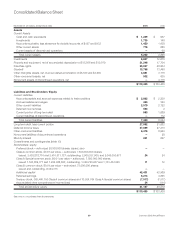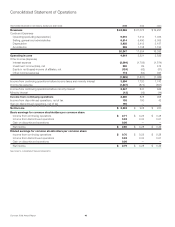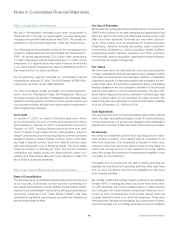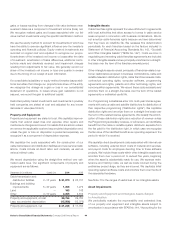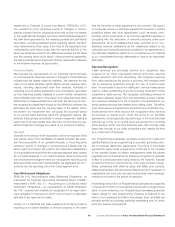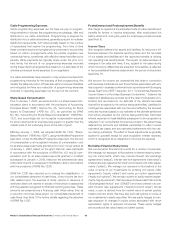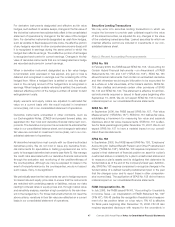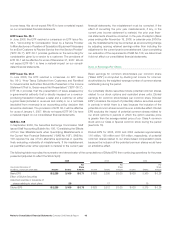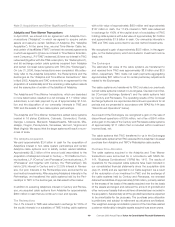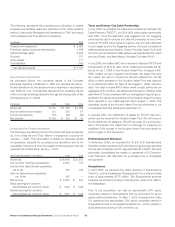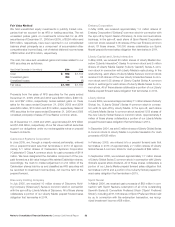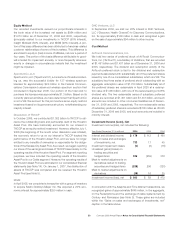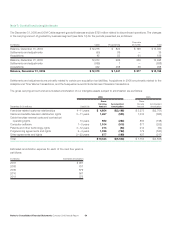Comcast 2006 Annual Report Download - page 48
Download and view the complete annual report
Please find page 48 of the 2006 Comcast annual report below. You can navigate through the pages in the report by either clicking on the pages listed below, or by using the keyword search tool below to find specific information within the annual report.Notes to Consolidated Financial Statements Comcast 2006 Annual Report 46
Cable Programming Expenses
Cable programming expenses are the fees we pay to program-
ming networks to license the programming we package, offer and
distribute to our cable subscribers. Programming is acquired for
distribution to our cable subscribers, generally pursuant to multiyear
distribution agreements, with rates typically based on the number
of subscribers that receive the programming. From time to time
these contracts expire and programming continues to be provided
based on interim arrangements while the parties negotiate new
contractual terms, sometimes with effective dates that affect prior
periods. While payments are typically made under the prior con-
tract terms, the amount of our programming expenses recorded
during these interim arrangements is based on our estimates of the
ultimate contractual terms expected to be negotiated.
Our cable subsidiaries have received or may receive incentives from
programming networks for the licensing of their programming. We
classify the deferred portion of these fees within noncurrent liabilities
and recognize the fees as a reduction of programming expenses
(included in operating expenses) over the term of the contract.
Share-Based Compensation
Prior to January 1, 2006, we accounted for our share-based com-
pensation plans in accordance with the provisions of Accounting
Principles Board (“APB”) Opinion No. 25, “Accounting for Stock
Issued to Employees” (“APB No. 25”), as permitted by SFAS
No. 123, “Accounting for Stock-Based Compensation” (“SFAS No.
123”), and accordingly did not recognize compensation expense
for stock options with an exercise price equal to or greater than the
market price of the underlying stock at the date of grant.
Effective January 1, 2006, we adopted SFAS No. 123R, “Share-
Based Payment” (“SFAS No. 123R”), using the Modified Prospective
Approach. Under the Modified Prospective Approach, the amount
of compensation cost recognized includes: (i) compensation cost
for all share-based payments granted prior to but not yet vested as
of January 1, 2006, based on the grant date fair value estimated
in accordance with the provisions of SFAS No. 123 and (ii) com-
pensation cost for all share-based payments granted or modified
subsequent to January 1, 2006, based on the estimated fair value
at the date of grant or subsequent modification date in accordance
with the provisions of SFAS No. 123R.
SFAS No. 123R also required us to change the classification, in
our consolidated statement of cash flows, of any income tax ben-
efits realized upon the exercise of stock options or issuance of
restricted share unit awards in excess of that which is associated
with the expense recognized for financial reporting purposes. These
amounts are presented as a financing cash inflow rather than as
a reduction of income taxes paid in our consolidated statement of
cash flows. See Note 10 for further details regarding the adoption
of SFAS No. 123R.
Postretirement and Postemployment Benefits
We charge to operations the estimated costs of retiree benefits and
benefits for former or inactive employees, after employment but
before retirement, during the years the employees provide services
(see Note 9).
Income Taxes
We recognize deferred tax assets and liabilities for temporary dif-
ferences between the financial reporting basis and the tax basis
of our assets and liabilities and the expected benefits of utilizing
net operating loss carryforwards. The impact on deferred taxes of
changes in tax rates and laws, if any, applied to the years during
which temporary differences are expected to be settled, is reflected
in the consolidated financial statements in the period of enactment
(see Note 11).
We account for income tax uncertainties that arise in connection
with business combinations and those that are associated with enti-
ties acquired in business combinations in accordance with Emerging
Issues Task Force (“EITF”) Issue No. 93-7, “Uncertainties Related to
Income Taxes in a Purchase Business Combination.” Deferred tax
assets and liabilities are recorded as of the date of a business com-
bination and are based on our estimate of the ultimate tax basis
that will be accepted by the various taxing authorities. Liabilities for
contingencies associated with prior tax returns filed by the acquired
entity are recorded based on our estimate of the ultimate settlement
that will be accepted by the various taxing authorities. Estimated
interest expense on these liabilities subsequent to the acquisition is
reflected in our consolidated income tax provision. We adjust these
deferred tax accounts and liabilities periodically to reflect revised
estimated tax bases and any estimated settlements with the vari-
ous taxing authorities. The effect of these adjustments is generally
applied to goodwill except for post-acquisition interest expense,
which is recognized as an adjustment of income tax expense.
Derivative Financial Instruments
We use derivative financial instruments for a number of purposes.
We manage our exposure to fluctuations in interest rates by enter-
ing into instruments, which may include interest rate exchange
agreements (“swaps”), interest rate lock agreements (“rate locks”),
interest rate cap agreements (“caps”) and interest rate collar agree-
ments (“collars”). We manage our exposure to fluctuations in the
value of some of our investments by entering into equity collar
agreements (“equity collars”) and equity put option agreements
(“equity put options”). We are also a party to equity warrant agree-
ments (“equity warrants”). We have issued indexed debt instruments
(“Exchangeable Notes” and “ZONES”) and have entered into pre-
paid forward sale agreements (“prepaid forward sales”) whose
value, in part, is derived from the market value of certain publicly
traded common stock. We have also sold call options on some of
our investments in equity securities. We use equity hedges to man-
age exposure to changes in equity prices associated with stock
appreciation rights of acquired companies. These equity hedges
are recorded at fair value based on market quotes.





